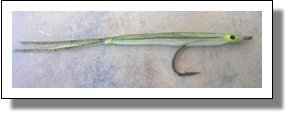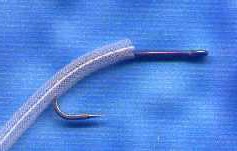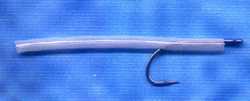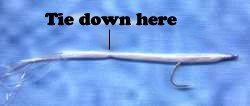
The Corsair Sand Eel (or Gartside Sand Eel) is a very simple fly to tie and a very effective one to fish where sand eels are an abundant source of food, such as Martha's Vineyard, Cape Cod and wherever else these tasty morsels may be found. I've received many requests for step-by-step tying instructions for this pattern and here they are, as described in my book, Original Salt Water Fly Patterns.
Sand eels (or sand launces) are found up and down the east coast and appear in a variety of colors and sizes, from one inch to eight or nine inches in some places. Chameleon-like, they are most often dark olive (or even purplish) when found on mud flats, almost transparent or creamish olive when found on light sandy bottoms. Considering this, it would be wise to tie your sand eels to suit the areas in which you fish.
The dressing below is for the standard Corsair Sand Eel, a highly realistic imitation, which is most effective when the fish are being picky. Since the body material is rather stiff (which is fine for realistic imitation), most of the action in the fly must come from the tail, which should be formed from a softer, more lively material (such as Glimmer, marabou, etc.). If a more active fly is desired, tie the body shorter and tie a longer tail.
Fishing tip: Sand eels are seldom "loners"; they most often appear in clusters and fish often feed on these by the mouthful. Therefore it's a good idea at times to fish two sand eel imitations at a time, by tying one to the bend of the other and fishing them in tandem. A deadly technique. Another idea: try fishing a Corsair Sand Eel attached to the bend of a Gurgler, another highly effective technique. However you fish it, you're sure to find the Corsair Sand Eel a great addition to your arsenal of flies.
Tying the Corsair Sand Eel
|
Hook: |
Mustad 34007, 34001, Daiichi 2546, #1-6 |
Eyes: |
Black on yellow |
|
Thread: |
6/0 white |
|
Body: |
1/4" white or silver/white Corsair tubing, length to vary |
|
Tail and Insert: |
Pearl Glimmer, Flashabou, Firefly tinsel, Sili-leg material, or combinations of these for different effects. For other interesting effects, try also marabou, mallard flank, peacock herl, Wiggle Tail, thin strips of leather or Bugskin. |
|
Head: |
White thread, top of which is colored to match the color of the body top |
|
Color: |
With marking pen, dark olive or brown or bluish-green on top and sides. Gray or dark olive lateral line. |
About Corsair Tubing
As with all flies tied with Corsair tubing, it's very important to take particular notice of the thread lines (one on each side) that run along its length. The thread lines control the density, flexibility, and the degree to which the material can be stretched and tapered as well as shaped. In addition these thread lines may also serve to suggest the lateral lines of the natural baitfish (in this case the sand eel). It's important also to remember that thread lines must be secured or tied down at both ends to allow proper tapering and to maintain the desired shape.
Corsair tubing may be found in many fly shops or may be ordered directly from this site.
 Cut 3" or 4" of 1/4" Corsair tubing and insert the point of the hook into the tubing (just like you might impale a worm) and push tubing up around the bend and halfway up the shank. Pierce the tubing with hook point between the thread lines.
Cut 3" or 4" of 1/4" Corsair tubing and insert the point of the hook into the tubing (just like you might impale a worm) and push tubing up around the bend and halfway up the shank. Pierce the tubing with hook point between the thread lines.
 Push the tubing further around the bend and further up the shank so that front portion of tubing is c. 1/2" behind the eye. The rear portion of tubing should be seated just forward of the bend so that the fly body comes off the shank in a straight line. (If the tubing is "curled," straighten it out by applying finger pressure to the opposite side of the curl.)
Push the tubing further around the bend and further up the shank so that front portion of tubing is c. 1/2" behind the eye. The rear portion of tubing should be seated just forward of the bend so that the fly body comes off the shank in a straight line. (If the tubing is "curled," straighten it out by applying finger pressure to the opposite side of the curl.)
 Attach your tying thread to the hook about 1/2" behind the eye of the hook. Insert a length of stiff but flexible wire (lead wire is best) and form a loop or hook. Cut c. 8" of Glimmer or some other flash material and drape it over the wire loop. Close the loop so that it traps the material and then draw the material through through the tubing and secure it about 1/2" behind the eye and tie down. Trim excess material if any.
Attach your tying thread to the hook about 1/2" behind the eye of the hook. Insert a length of stiff but flexible wire (lead wire is best) and form a loop or hook. Cut c. 8" of Glimmer or some other flash material and drape it over the wire loop. Close the loop so that it traps the material and then draw the material through through the tubing and secure it about 1/2" behind the eye and tie down. Trim excess material if any.
 Tie down tubing 1/2" behind the eye, forming a neat, tapered head. Whip finish.
Tie down tubing 1/2" behind the eye, forming a neat, tapered head. Whip finish.
 Taper the rear portion of tubing (by squeezing and stretching the tubing, thus loosening the thread lines and narrowing the diameter of the tubing. Wrap turns of thread around the point where you want your body to end and whip finish. Head cement your thread wraps and trim any excess material.
Taper the rear portion of tubing (by squeezing and stretching the tubing, thus loosening the thread lines and narrowing the diameter of the tubing. Wrap turns of thread around the point where you want your body to end and whip finish. Head cement your thread wraps and trim any excess material.
Finally, color both the top of the sand eel and its thread lines with an olive water- resistant pen and paint eyes with fabric paint. Add a second coat of cement to the eyes after they're dry.






